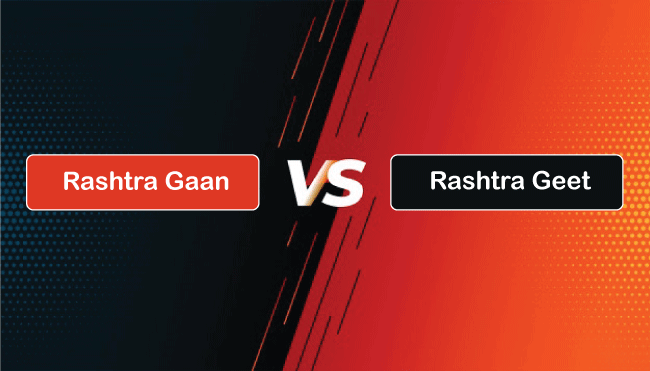Difference between Rashtra Gaan and Rashtra Geet
We all are citizens of our country with "Rashtra gaan" and "rashtra geet" as our heritage. They are also called "National Anthem" and "National Song," making every country's unique identity. At every national occasion (independence day, republic day, all public functions), national or international games, these patriotic are sung before starting, increasing the feeling of patriotism in mind. Usually, people consider rashtra gaan and rashtra geet the same, especially those countries that don't have national songs but are different in their terms. Let's understand the difference between rashtra gaan and rashtra geet.
About rashtra gaan of India
The rashtra gaan of India (patriotic song) comprises thirty-two stanzas symmetrically organized into eight sections of four lines each. Jana-gana-mana-adhinayaka, jaya he Meaning:"The ruler of the mind of all people, Kala, you are the maker of India's destiny. This line is dedicated to the citizens of India, as the citizen is the real master in a democracy. The next lines are bowing down to the land of India, your name stirs the hearts of the Punjab, Sindh, Gujarat and the Marathas as well as Bengal, Odisha, and the Dravidians, echoes in the mountains of the Vindhyas and the Himalayas, mingles with the music of the Ganges and the Jamuna, and fills the waters of the Indian Ocean. Praised by the waves. They pray for your blessings and sing songs of your praise. The next lines are dedicated to the soldiers and farmers of the country. You are the one who provides security and good life to all living beings, and you are the real destiny maker of India, Jai Ho Tumhari. This nation has been made by meeting all of you, so you are hailed. Some of its features are:-
Occasions on which rashtra gaan playedFull singing of the national anthem is completed in approximately 52 sec., and in fast track, it is completed in about 20 seconds. This country's symbol of pride is played on designated and special occasions like:
History:The rashtra gaan was sung on the second day of the Indian National Congress annual session in Calcutta on December 27, 1911. It was sung in front of prominent members of Congress like Indian National Congress President Bishan Narayan Dhar and Ambika Charan Majumdar by Sarla devi Chowdhury (Tagore's niece) along with a group of school students. The song was published in the Tatwabodhini Patrika under the title Bharat Bhidhata of which Tagore was the editor. February 28, 1919: The song was sung outside Calcutta, in Andhra Pradesh, by the bard himself at a session in Besant Theosophical College in Madanapalle. College authorities liked this song and adopted its English version as their prayer song, which is sung daily today. August 14, 1947: After independence, the first Indian Constituent Assembly was held, and at midnight, the session closed with the performance of Jana Gana Mana. On January 24, 1950, the Constituent Assembly of India officially proclaimed it as India's National Anthem. Code of conduct to be followed by every Indian citizen during Nation Anthem:
About rashtra geet of IndiaThe rashtra geet of India, "Vande Mataram," was written by Bankim Chandra Chatterjee and composed in Sanskrit- Bengali mixed language. This song reflects the country's pride and has the same status as the national anthem. It was published as an embedded song in Bankim Chandra Chattopadhyay's novel Anand Math in 1882. In this novel, this song is sung by a sannyasin named Bhavananda. Its tune was composed by Yadunath Bhattacharya. ."Vande Mataram" received the status of the national song for the first time in the meeting of the Congress Working Committee in the year 1905. On January 24, 1950, the first two verses of Vande Mataram were officially declared the national song of India by the Constitution of India. In those days, when the movement of 'Bang-Bang' was in full swing in Bengal, on the other hand, Mahatma Gandhi's non-cooperation movement awakened public sentiment, and this song became a holy mantra for the freedom fighters. The two words of 'Vande Mataram' ignited patriotism in the countrymen's hearts at that time. Even today, 'Vande Mataram' is sung in every corner of the country with the same spirit of patriotism. In 2003, an international poll conducted by the BBC World Service polled approximately 7,000 songs from around the world, and according to the BBC, people from 155 countries/islands choose the ten most famous songs of all time. Vande Mataram was ranked second in the top 10 songs polled by them. This song for our nation and motherland sing by individuals on various national events and occasions. It fills our hearts with enthusiasm toward our country. Words of rashtra geetVande mataram, Vande mataram The first two stanzas of the original song 'Vande Mataram' were in Sanskrit, and the remaining were in Bengali. Rashtrakavi Rabindranath Tagore sang this song in Bengali style with rhythm and music for the first time in 1896 at the Calcutta session of the Congress. This song was translated into English by Aurobindo Ghosh and Urdu by Arif Mohammad Khan. The first stanza of the original song 'Vande Mataram' has been recognized as the official song. By giving it the status of the national song, not only its tune but also its duration has been fixed by the Constituent Assembly, which is 52 seconds. With this song, we thank our motherland for being richly watered, fruited cool with the south winds, and dark with harvest crops. Rejoice in the glory of moonlight at night, and her land is beautifully clothed with trees, flowers, sweet of speech, sweet of laughter. Thanks, motherland, for being a giver of boons and bliss.
Next TopicDifference between
|
 For Videos Join Our Youtube Channel: Join Now
For Videos Join Our Youtube Channel: Join Now
Feedback
- Send your Feedback to [email protected]
Help Others, Please Share










